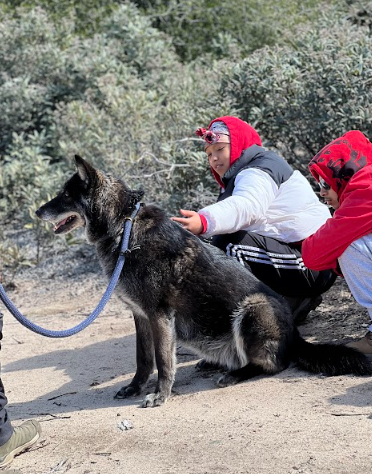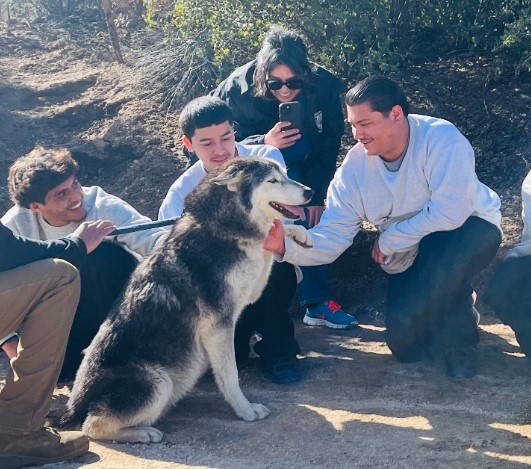The unique connection between wolves and humans has been researched and chronicled in film, literature, and art. Additionally, the connection between teenagers and wolves might even be more aligned as both have a strong need to belong socially, are often misunderstood or misrepresented, and sometimes are even abused and neglected.
This special relationship is at the center of the work at Wolf Connection – a unique 165-acre educational sanctuary in southern California that brings people together through direct relationships with rescued wolves for the purpose of empowering the next generation to become authentic leaders and stewards of the earth.
The team at Wolf Connection supports at-risk youth by reconnecting with nature, learning to be of service by responsibly caring for another being, and by working towards becoming the kind of person they want to be through Wolf Connection’s trademarked Wolf Therapy.
The wolves help the teenagers focus on their impulses, feelings, and emotions in a constructive way, according to Executive Director Amanda Beer. She said that the students learn to forgive and give to others (and themselves) and experience a second chance.
“Like wolves and wolf-dogs, teenagers are often misunderstood,” said Beer. “Our signature programming centers around a coming-of-age process with wolves as our teachers, inviting us to connect to our inner wisdom as well as the wisdom of our packmates.”


The team at Wolf Connection said the idea originated after Founder & CEO Teo Alfero found himself caring for a pack of 16 rescued wolves and wolf dogs. Alfero chronicled his journey with the wolves with his book entitled The Wolf Connection: What Wolves Can Teach Us About Being Human.
According to the team, the inaugural youth program began with 10 schools participating in an eight-week Empowerment Program where students visit with the wolves weekly. This has now expanded to include a 12-week online program called Wolf Lessons For Human Lives that provides either asynchronous or synchronous options for the classroom based on the CASEL Social Emotional Learning Competencies. The online program concludes with students being able to meet the wolves. According to Beer, many schools are using this online course as an elective, as part of advisory, or even in EL supplementation.
Although the focus has been on at-risk youth, Beer said that programs at Wolf Connection are expanding into adult offerings including a curriculum focused on women, veterans, incarcerated adults, and those recovering from drug and alcohol addiction. However, she said the primary focus will remain on supporting youth.
“Wolves are like families. Young people have been the entry point. The more we do this work, the more we see the level of crisis of those taking care of the teens (parents, teachers, counselors),” said Beer. “We often want to label kids, but we must remember they are being taken care of by adults.”
Ultimately, Beer said all of the interest and sold out events suggest that people are seeking connection, support, and help across the human spectrum.
Wolf Connection has received overwhelmingly positive feedback from all those connected to any of the programs.
Counselors and mental health professionals are enthusiastic about the results.
“As a professional who has worked in the Juvenile Justice system for 20 years, this is one of the most meaningful curriculums that I have seen,” said one community partner. “From a clinical perspective, this program allows the youth to connect their own stories to the stories of the wolves they learn about.”
Youth participants have also been very positive about the experience. Indeed, three former participants are now working at Wolf Connection.
One recent program graduate said that before he went through the program he was closed off and suffered from severe anger. However, he now feels that he can express his emotions and become a better version of himself.
“I like the wolves’ background stories as they too have trauma. We all go through tough times and feel like our scars are not going to heal,” he said. “After seeing the wolves, I get inspired to push through – like I can do the same thing.”
Staff members at Wolf Connection are often asked about what makes it all work so well. Wolf Connection Lead of High School Programs James Bigelow said that the secret sauce is when students and adults can see themselves in the experience of the wolves.
“I think it’s about participants beginning to understand their internal, emotional landscapes. These landscapes mirror the natural landscape,” said Bigelow. “One example is the four different seasons and how emotions often come in seasons.”
With 40 employees and 40 volunteers, Beer said that one of the overarching goals of Wolf Connection is to be the global storyteller for wolves and their connections to humans.
“The virtual programs are a huge push for us as people don’t have to meet the wolves in person to benefit from them,” said Beer. “The stories of wolves – with lessons about relationships, resilience, and survival – represent tremendous learning opportunities for all of us.”
The post At-Risk Youth Discover Support, Healing With Wolves appeared first on Getting Smart.
from Getting Smart https://www.gettingsmart.com/2024/04/22/at-risk-youth-discover-support-healing-with-wolves/